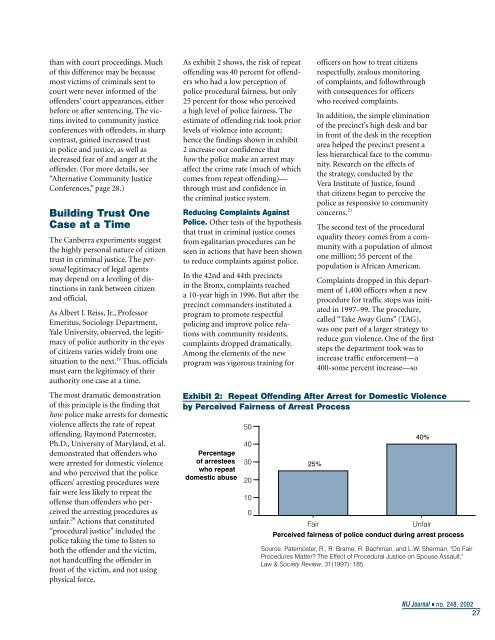Trust and Confidence in Criminal Justice - National Criminal Justice ...
Trust and Confidence in Criminal Justice - National Criminal Justice ...
Trust and Confidence in Criminal Justice - National Criminal Justice ...
Create successful ePaper yourself
Turn your PDF publications into a flip-book with our unique Google optimized e-Paper software.
than with court proceed<strong>in</strong>gs. Much<br />
of this difference may be because<br />
most victims of crim<strong>in</strong>als sent to<br />
court were never <strong>in</strong>formed of the<br />
offenders’ court appearances, either<br />
before or after sentenc<strong>in</strong>g. The victims<br />
<strong>in</strong>vited to community justice<br />
conferences with offenders, <strong>in</strong> sharp<br />
contrast, ga<strong>in</strong>ed <strong>in</strong>creased trust<br />
<strong>in</strong> police <strong>and</strong> justice, as well as<br />
decreased fear of <strong>and</strong> anger at the<br />
offender. (For more details, see<br />
“Alternative Community <strong>Justice</strong><br />
Conferences,” page 28.)<br />
Build<strong>in</strong>g <strong>Trust</strong> One<br />
Case at a Time<br />
The Canberra experiments suggest<br />
the highly personal nature of citizen<br />
trust <strong>in</strong> crim<strong>in</strong>al justice. The personal<br />
legitimacy of legal agents<br />
may depend on a level<strong>in</strong>g of dist<strong>in</strong>ctions<br />
<strong>in</strong> rank between citizen<br />
<strong>and</strong> official.<br />
As Albert J. Reiss, Jr., Professor<br />
Emeritus, Sociology Department,<br />
Yale University, observed, the legitimacy<br />
of police authority <strong>in</strong> the eyes<br />
of citizens varies widely from one<br />
situation to the next. 19 Thus, officials<br />
must earn the legitimacy of their<br />
authority one case at a time.<br />
The most dramatic demonstration<br />
of this pr<strong>in</strong>ciple is the f<strong>in</strong>d<strong>in</strong>g that<br />
how police make arrests for domestic<br />
violence affects the rate of repeat<br />
offend<strong>in</strong>g. Raymond Paternoster,<br />
Ph.D., University of Maryl<strong>and</strong>, et al.<br />
demonstrated that offenders who<br />
were arrested for domestic violence<br />
<strong>and</strong> who perceived that the police<br />
officers’ arrest<strong>in</strong>g procedures were<br />
fair were less likely to repeat the<br />
offense than offenders who perceived<br />
the arrest<strong>in</strong>g procedures as<br />
unfair. 20 Actions that constituted<br />
“procedural justice” <strong>in</strong>cluded the<br />
police tak<strong>in</strong>g the time to listen to<br />
both the offender <strong>and</strong> the victim,<br />
not h<strong>and</strong>cuff<strong>in</strong>g the offender <strong>in</strong><br />
front of the victim, <strong>and</strong> not us<strong>in</strong>g<br />
physical force.<br />
As exhibit 2 shows, the risk of repeat<br />
offend<strong>in</strong>g was 40 percent for offenders<br />
who had a low perception of<br />
police procedural fairness, but only<br />
25 percent for those who perceived<br />
a high level of police fairness. The<br />
estimate of offend<strong>in</strong>g risk took prior<br />
levels of violence <strong>in</strong>to account;<br />
hence the f<strong>in</strong>d<strong>in</strong>gs shown <strong>in</strong> exhibit<br />
2 <strong>in</strong>crease our confidence that<br />
how the police make an arrest may<br />
affect the crime rate (much of which<br />
comes from repeat offend<strong>in</strong>g)—<br />
through trust <strong>and</strong> confidence <strong>in</strong><br />
the crim<strong>in</strong>al justice system.<br />
Reduc<strong>in</strong>g Compla<strong>in</strong>ts Aga<strong>in</strong>st<br />
Police. Other tests of the hypothesis<br />
that trust <strong>in</strong> crim<strong>in</strong>al justice comes<br />
from egalitarian procedures can be<br />
seen <strong>in</strong> actions that have been shown<br />
to reduce compla<strong>in</strong>ts aga<strong>in</strong>st police.<br />
In the 42nd <strong>and</strong> 44th prec<strong>in</strong>cts<br />
<strong>in</strong> the Bronx, compla<strong>in</strong>ts reached<br />
a 10-year high <strong>in</strong> 1996. But after the<br />
prec<strong>in</strong>ct comm<strong>and</strong>ers <strong>in</strong>stituted a<br />
program to promote respectful<br />
polic<strong>in</strong>g <strong>and</strong> improve police relations<br />
with community residents,<br />
compla<strong>in</strong>ts dropped dramatically.<br />
Among the elements of the new<br />
program was vigorous tra<strong>in</strong><strong>in</strong>g for<br />
officers on how to treat citizens<br />
respectfully, zealous monitor<strong>in</strong>g<br />
of compla<strong>in</strong>ts, <strong>and</strong> followthrough<br />
with consequences for officers<br />
who received compla<strong>in</strong>ts.<br />
In addition, the simple elim<strong>in</strong>ation<br />
of the prec<strong>in</strong>ct’s high desk <strong>and</strong> bar<br />
<strong>in</strong> front of the desk <strong>in</strong> the reception<br />
area helped the prec<strong>in</strong>ct present a<br />
less hierarchical face to the community.<br />
Research on the effects of<br />
the strategy, conducted by the<br />
Vera Institute of <strong>Justice</strong>, found<br />
that citizens began to perceive the<br />
police as responsive to community<br />
concerns. 21<br />
The second test of the procedural<br />
equality theory comes from a community<br />
with a population of almost<br />
one million; 55 percent of the<br />
population is African American.<br />
Compla<strong>in</strong>ts dropped <strong>in</strong> this department<br />
of 1,400 officers when a new<br />
procedure for traffic stops was <strong>in</strong>itiated<br />
<strong>in</strong> 1997–99. The procedure,<br />
called “Take Away Guns” (TAG),<br />
was one part of a larger strategy to<br />
reduce gun violence. One of the first<br />
steps the department took was to<br />
<strong>in</strong>crease traffic enforcement—a<br />
400-some percent <strong>in</strong>crease—so<br />
Exhibit 2: Repeat Offend<strong>in</strong>g After Arrest for Domestic Violence<br />
by Perceived Fairness of Arrest Process<br />
Percentage<br />
of arrestees<br />
who repeat<br />
domestic abuse<br />
50<br />
40<br />
30<br />
20<br />
10<br />
0<br />
25%<br />
40%<br />
Fair Unfair<br />
Perceived fairness of police conduct dur<strong>in</strong>g arrest process<br />
Source: Paternoster, R., R. Brame, R. Bachman, <strong>and</strong> L.W. Sherman, "Do Fair<br />
Procedures Matter? The Effect of Procedural <strong>Justice</strong> on Spouse Assault,"<br />
Law & Society Review, 31(1997): 185.<br />
NIJ Journal ■ no. 248, 2002<br />
27

















